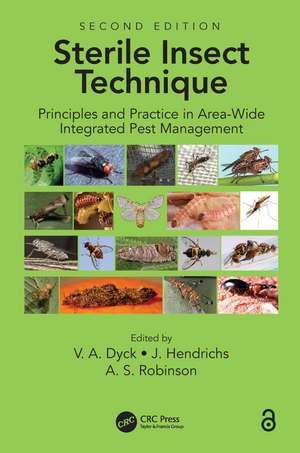Sterile Insect Technique: Principles And Practice In Area-Wide Integrated Pest Management
Editat de Victor A. Dyck, Jorge Hendrichs, A.S. Robinsonen Limba Engleză Hardback – apr 2021
Preț: 1024.25 lei
Preț vechi: 1388.45 lei
-26% Nou
Puncte Express: 1536
Preț estimativ în valută:
195.99€ • 205.21$ • 162.56£
195.99€ • 205.21$ • 162.56£
Comandă specială
Livrare economică 20 martie-03 aprilie
Doresc să fiu notificat când acest titlu va fi disponibil:
Se trimite...
Preluare comenzi: 021 569.72.76
Specificații
ISBN-13: 9780367474348
ISBN-10: 0367474344
Pagini: 1216
Ilustrații: 266
Dimensiuni: 174 x 246 mm
Greutate: 2.53 kg
Ediția:2
Editura: CRC Press
Colecția CRC Press
ISBN-10: 0367474344
Pagini: 1216
Ilustrații: 266
Dimensiuni: 174 x 246 mm
Greutate: 2.53 kg
Ediția:2
Editura: CRC Press
Colecția CRC Press
Public țintă
Academic and Professional Practice & DevelopmentCuprins
PART I. INTRODUCTION . History Of The Sterile Insect Technique. Misconceptions And Constraints Driving Opportunities. PART II. PRINCIPLES OF THE STERILE INSECT TECHNIQUE. Area-Wide Integrated Pest Management And The Sterile Insect Technique. Biological Basis Of The Sterile Insect Technique. Genetic Basis Of The Sterile Insect Technique. Inherited Sterility In Insects. Mathematical Models For Using Sterile Insects. PART III. TECHNICAL COMPONENTS OF THE STERILE INSECT TECHNIQUE. Role Of Population And Behavioural Ecology In The Sterile Insect Technique. Mass-Rearing For The Sterile Insect Technique. Managing Pathogens In Insect Massrearing For The Sterile Insect Technique, With The Tsetse Fly Salivary Gland Hypertrophy Virus As An Example. Sterilizing Insects With Ionizing Radiation. Sterile Insect Quality Control/Assurance. Supply, Emergence, And Release Of Sterile Insects. Monitoring Sterile And Wild Insects In Area-Wide Integrated Pest Management Programmes. PART IV. SUPPORTIVE TECHNOLOGIES TO IMPROVE THE STERILE INSECT TECHNIQUE. Role Of Population Genetics In The Sterile Insect Technique. Population Suppression In Support Of The Sterile Insect Technique. Practical And Operational Genetic Sexing Systems Based On Classical Genetic Approaches In Fruit Flies, An Example For Other Species Amenable To Large-Scale Rearing For The Sterile Insect Technique. Insect Symbiosis In Support Of The Sterile Insect Technique. Improving Post-Factory Performance Of Sterile Male Fruit Flies In Support Of The Sterile Insect Technique. Applying Modern Molecular Technologies In Support Of The Sterile Insect Technique. Using Geographic Information Systems And Spatial Modelling In Area-Wide Integrated Pest Management Programmes That Integrate The Sterile Insect Technique. PART V. ECONOMIC, ENVIRONMENTAL, AND MANAGEMENT CONSIDERATIONS. Design And Economic Evaluation Of Programmes Integrating The Sterile Insect Technique. Environment And The Sterile Insect Technique. Management Of Area-Wide Pest Management Programmes That Integrate The Sterile Insect Technique. Communication And Stakeholder Engagement In Area-Wide Pest Management Programmes That Integrate The Sterile Insect Technique. PART VI. APPLICATION OF THE STERILE INSECT TECHNIQUE. Strategic Options In Using Sterile Insects For Area-Wide Integrated Pest Management. Invasive Insect Pests: Challenges And The. Role Of The Sterile Insect Technique In Their Prevention, Containment, And Eradication. Procedures For Declaring Pest Free Status. PART VII. IMPACT OF AREA-WIDE PEST MANAGEMENT PROGRAMMES THAT INTEGRATE THE STERILE INSECT TECHNIQUE. Impact Of Screwworm Eradication Programmes Using The Sterile Insect Technique. Impact Of Fruit Fly Control Programmes Using The Sterile Insect Technique. Impact Of Moth Suppression/Eradication Programmes Using The Sterile Insect Technique Or Inherited Sterility. Impact Of Tsetse Fly Eradication Programmes Using The Sterile Insect Technique. Potential Impact Of Integrating The Sterile Insect Technique Into The Fight Against Disease-Transmitting Mosquitoes.Prospects For The Future Development And Application Of The Sterile Insect Technique
Notă biografică
Victor A. Dyck, Jorge Hendrichs, A.S. Robinson
Descriere
This second edition of the IAEA's bestselling Sterile Insect Technique responds to major advances since 2005 in the technology of the SIT. Six brand new chapters capture the latest developments in the SIT technology.
